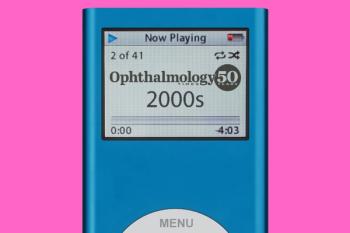
Blog: Refractive Surgery and the Risk of Retinal Detachment
Mark Packer, MD, shares his perspective on the relationship between ICL implantation or LASIK and retinal detachment.
Editor's note: The views expressed in this blog are those of their respective contributor and do not represent the views of Ophthalmology Times® or MJH Life Sciences®
Given the frequency with which refractive surgery is performed for moderate to high myopia, whether the procedure is phakic refractive lens implantation, LASIK or SMILE, the question of a relationship with retinal detachment often comes up.
Regarding the risk of retinal detachment in the general population, including all types of refractive error, a meta-analysis of complications of myopia published in 2020 indicated that “Annual incidence rates of RD [retinal detachment] ranged from 5.4 per 100,000 persons in Croatia (95% CI, 4.1–6.4), to 16.5 per 100,000 persons in Japan (95% CI, 15.0–18.1).”1 The authors noted that, “Five case-control studies were available for meta-analyses to determine the relationship between myopia and RD in various refractive error categories. All but one study showed a significant higher odds of RD for myopic persons (<0 D) compared with nonmyopic persons.” Of the studies reviewed in this publication, two reported on the US population:
- The Eye Disease Case-Control Study Group reported that “An eye with a spherical equivalent refractive error of -1 to -3 diopters had a fourfold increased risk of retinal detachment compared with a nonmyopic eye; if the refractive error was greater than -3 diopters, the risk was increased 10-fold."2
- Based on “the correlation of the type of retinal detachment, age of onset, and refractive error for the 172 residents of the State of Iowa who developed retinal detachments during the year 1976,” Burton reported that the annual incidence of retinal detachment among the US population with myopia greater than -3.1 D was 117 in 100,000, i.e., 15 for eyes -3.1 to -5.0 plus 102 for eyes > -5.0, or 0.11%. In eyes with lattice degeneration, the annual incidence of retinal detachment in eyes with myopia greater than 3.1 D increased to 435 per 100,000, or 0.44%.3 According to the meta-analysis performed by Haarman et al,1 Burton’s paper is the only investigation of the annual incidence of retinal detachment per degree of refractive error.
The risk of retinal detachment for patients implanted with MICL lenses as reported in the MICL DFU is 0.19% (1/526) during the first year following implantation compared with the 0.11% annual incidence reported by Burton.4 However, a review of the literature reporting safety outcomes for EVO ICL lenses with the central port design including data from 28 publications of prospective or retrospective case series demonstrated a 0.034% incidence of retinal detachment (1/2,970 eyes) with weighted average follow-up of 16.7 months.5 This rate is actually less than the population-based rate reported by Burton.
Regarding the risk of retinal detachment following LASIK, reported rates have varied from 0.022% to 0.25%.6 These rates are similar to those reported for the moderate to high myopic population, as well as the rates reported following ICL implantation.
Regarding etiology, the risk of retinal detachment in myopia is attributed to anatomic and physiologic characteristics of myopic eyes: “In addition to axial length greater than or equal to 26 mm, the high myopic eye exhibits a thin and fragile sclera, choroidal hemodynamic changes, early and strong vitreous liquefaction followed by earlier posterior vitreous detachment and complex vitreous–retinal interface, pathologic vitreoretinal attachments with higher peripheral retinal break occurrence, irregularity of the posterior border of the vitreous base, and weak retinal adhesion."7
Specifically regarding retinal detachment following posterior chamber phakic IOL implantation, “data suggest that these retinal detachments are part of the natural history of retinal detachment in high-degree myopia."8 Authors have concluded that “we cannot demonstrate that the correction of high myopia by the implantation of phakic lenses plays a role in the eventual occurrence of retinal detachment."9 The American Academy of Ophthalmology Preferred Practice Pattern further states, “Phakic intraocular lenses have not been associated with increased risk of retinal detachment compared with other intraocular interventions in highly myopic patients.”10
In summary, there is no convincing evidence to support a causal relationship between ICL implantation or LASIK and retinal detachment. As noted in the TICL DFU, “The relationship between the Visian TICL and retinal detachment is undetermined.”4 In this light, it remains prudent to inform all myopic patients of their increased risk of retinal detachment, and to counsel them regarding the warning symptoms of flashes and floaters, to facilitate timely treatment and the best possible outcomes.
References:
1. Haarman AEG, Enthoven CA, Tideman JWL, Tedja MS, Verhoeven VJM, Klaver CCW. The Complications of Myopia: A Review and Meta-Analysis. Invest Ophthalmol Vis Sci. 2020 Apr 9;61(4):49.
2. Risk factors for idiopathic rhegmatogenous retinal detachment. The Eye Disease Case-Control Study Group. Am J Epidemiol. 1993 Apr 1;137(7):749-57.
3. Burton TC. The influence of refractive error and lattice degeneration on the incidence of retinal detachment. Trans Am Ophthalmol Soc. 1989;87:143-55; discussion 155-7.
4. https://www.accessdata.fda.gov/cdrh_docs/pdf3/P030016S001d.pdf (Accessed March 16, 2022)
5. Packer M. The Implantable Collamer Lens with a central port: review of the literature. Clin Ophthalmol. 2018 Nov 27;12:2427-2438.
6. Kanclerz P, Grzybowski A. Does Corneal Refractive Surgery Increase the Risk of Retinal Detachment? A Literature Review and Statistical Analysis. J Refract Surg. 2019 Aug 1;35(8):517-524.
7. Bernheim D, Rouberol F, Palombi K, Albrieux M, Romanet JP, Chiquet C. Comparative prospective study of rhegmatogenous retinal detachments in phakic or pseudophakic patients with high myopia. Retina. 2013 Nov-Dec;33(10):2039-48.
8. Martínez-Castillo V, Boixadera A, Verdugo A, Elíes D, Coret A, García-Arumí J. Rhegmatogenous retinal detachment in phakic eyes after posterior chamber phakic intraocular lens implantation for severe myopia. Ophthalmology. 2005;112(4):580-585.
9. Ruiz-Moreno JM, Montero JA, de la Vega C, Alió JL, Zapater P. Retinal detachment in myopic eyes after phakic intraocular lens implantation. J Refract Surg. 2006 Mar;22(3):247-52.
10. Flaxel CJ, Adelman RA, Bailey ST, Fawzi A, Lim JI, Vemulakonda GA, Ying GS. Posterior Vitreous Detachment, Retinal Breaks, and Lattice Degeneration Preferred Practice Pattern®. Ophthalmology. 2020 Jan;127(1):P146-P181.
Newsletter
Don’t miss out—get Ophthalmology Times updates on the latest clinical advancements and expert interviews, straight to your inbox.



















































.png)


